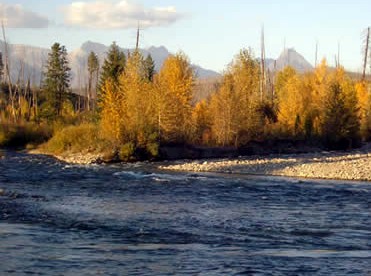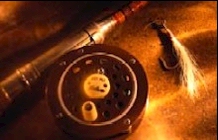The North Fork Flathead River originates
50 miles across the border in British Columbia, Canada.
The river brings with it the rugged remoteness that one
would expect from the Canadian Rockies. The remoteness
is what brings people to this part of Montana and itís
the scenic beauty that keeps bringing them back. The
North Fork Flathead River divides the Flathead National
Forest from Glacier National Park.
The upper 41 miles
above the Camas Creek Bridge are classified as Scenic
under the 1976 Wild and Scenic Rivers Act. The lower 17
mile section to Blankenship Bridge and the confluence of
the Middle Fork is classified as Recreational. Awe
inspiring views into Glacier National Park are common
from the river. Less inspiring is the fishing this is one river where a die-hard
angler can spend more time looking up at the scenery
than watching his fly. Just when you begin drifting into
the harmony of the water and the views, one of those
slashing little westslope cutthroat trout will be sure
to bring your interest back to the water.
is one river where a die-hard
angler can spend more time looking up at the scenery
than watching his fly. Just when you begin drifting into
the harmony of the water and the views, one of those
slashing little westslope cutthroat trout will be sure
to bring your interest back to the water.
Fish in the North Fork run on the
small size (8-12Ē) because when the parent rock,
argillite, breaks down it doesnít contain much of the
big fish producing nutrients that can be found in the
productive limestone waters elsewhere in Montana.
Secondly, these waters are cold, being fed by
groundwater and glacier fed streams. However, if you
time your trip right, before spring runoff, you can
catch larger westslope cutthroat trout that migrate from
Flathead Lake on their spring spawning runs. Westslope
cutthroat trout and bull trout in the Flathead River
basin are adfluvial, that is they spend time in Flathead
Lake rearing to adulthood until its time to spawn. Once
they are sexually mature (4-6 years) they migrate into
tributary streams, some migrations are over 100 miles,
to spawn (cutthroat in the spring and bull trout in the
fall). Once the fry emerge from the gravels, juveniles
will rear in these tributaries for 1-3 years until they
migrate back to Flathead Lake.
Adfluvial bull trout and westslope
cutthroat from Flathead Lake have declined due to
changes in the lakes food web. Opossum shrimp, mysis
relicta, were planted in upstream lakes in 1967 and
1968. They drifted down rivers into Flathead Lake
becoming established in the late 1970ís and peaking in
the mid 1980ís. Mysis consumed the majority of
zooplankton, thereby causing non-native kokanee salmon
populations to crash due to starvation. Other fish, such
as non-native lake trout and lake whitefish thrived in
these conditions to the detriment of native fish. The
food web in
Flathead Lake is most likely still changing
and it is difficult to predict what the outcome may be.
Species Present: Westslope
Cutthroat Trout, Bull Trout, and Mountain Whitefish.
Non-native Rainbow Trout are becoming increasingly
common in the lower section of the river.
Seasons: Opening is the third
Saturday in May through November 30, however, there is
an extended catch and release season for trout and a 50
daily limit for whitefish for the rest of the year. The
river is catch and release for cutthroat trout and a
daily limit of 2 for rainbow trout. An angler needs to
check the regulations as many tributary streams are
closed to fishing to protect spawning bull trout and
cutthroat trout. Note: It is illegal to take or
intentionally fish for bull trout.
Access: Excellent access is
provided by the North Fork Road which can be accessed
just north of Columbia Falls. This county maintained
road parallels the river along itís entire length. Be
prepared for dusty conditions! Blankenship Bridge is
your first access at the confluence of the Middle Fork
Flathead River, followed upriver by: Glacier Rim, Big
Creek, Coal Creek, Polebridge, Ford, and Border river
access at the Canada-USA border. The North Fork is an
excellent river to float in rafts and canoes but it is
recommended that the novice canoeist wait until flows
recede in July. Dangerous sweeper logs can be common and
the braided channels just below Coal Creek suggest that
you check in advance with the Ranger Station for the
latest conditions.
Camping: Big Creek Campground
is an excellent choice for camping as are the numerous
dispersed sites along the river. Campgrounds can also be
found in Glacier National Park. Lastly, Ford, Shnaus and
Ben Rover are 3 rental cabins that provide great
accommodations. Please check with the Hungry Horse
Ranger Station on the availability of these cabins.





